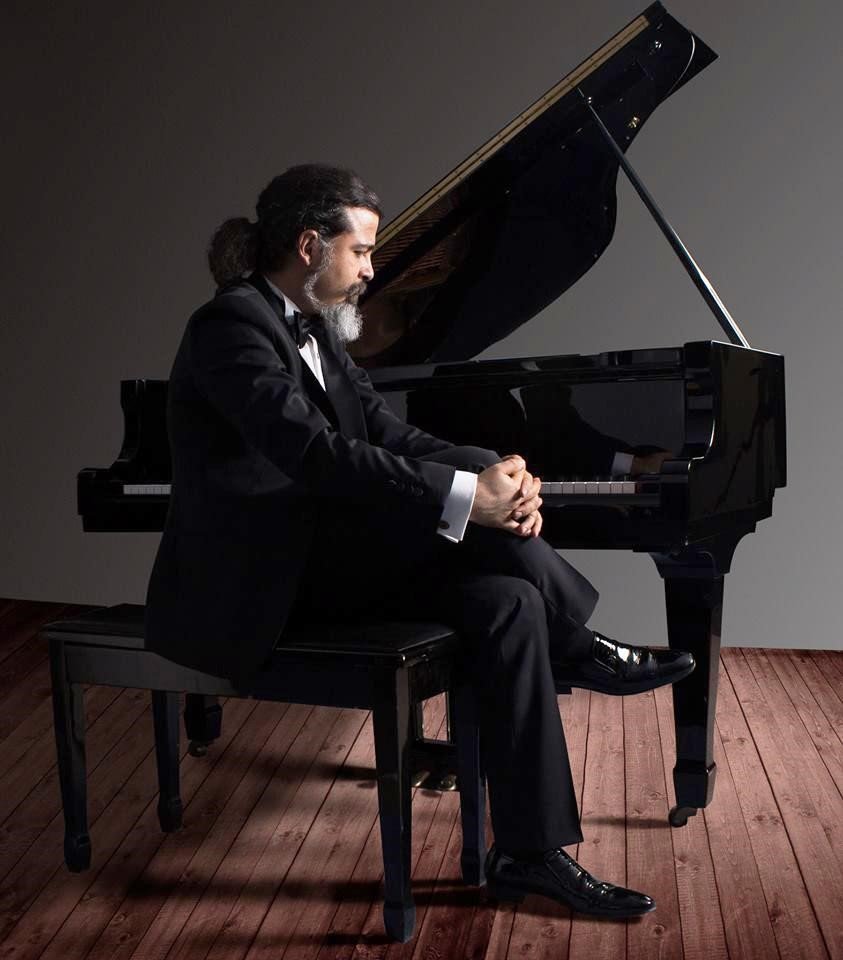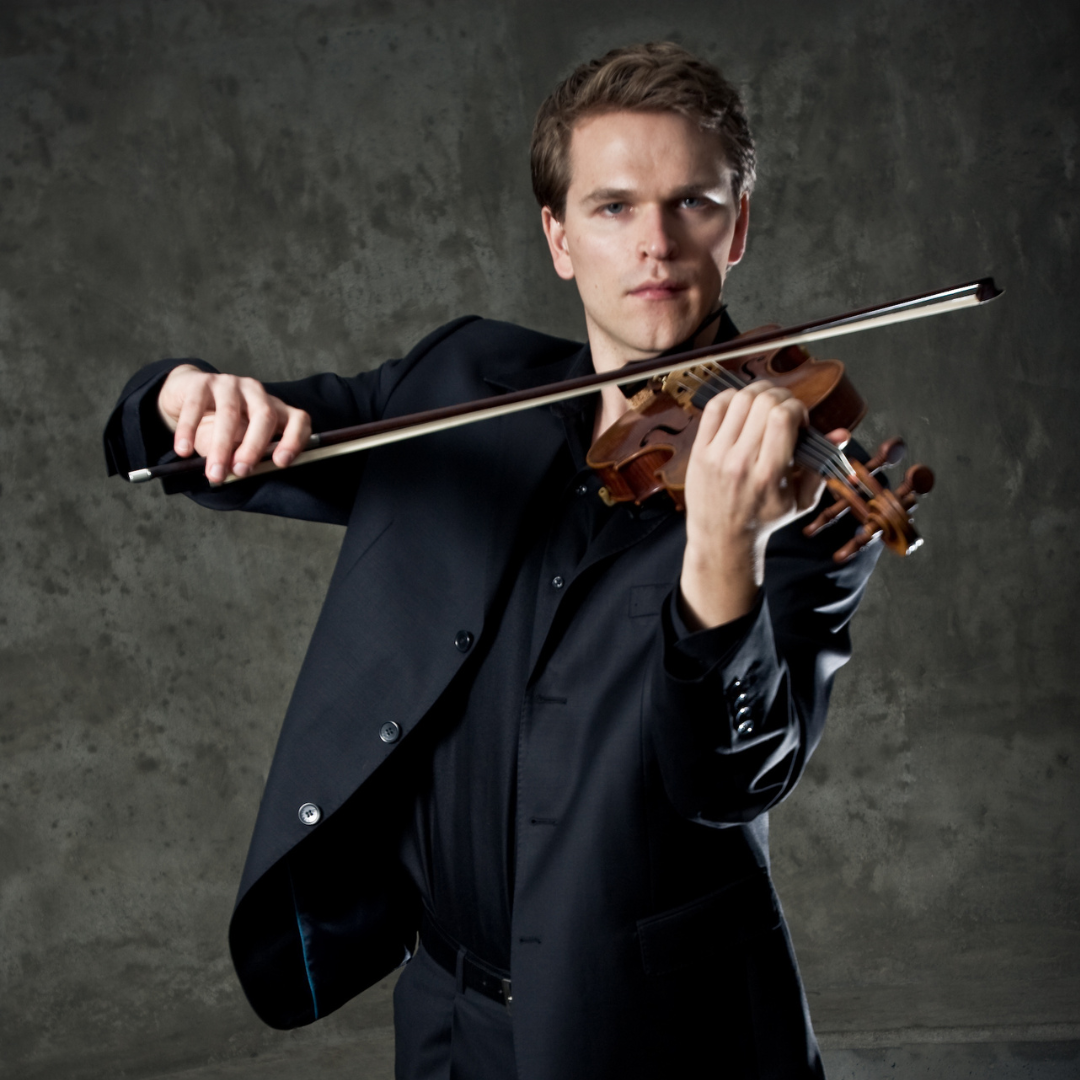Wow! The 2023-2024 season of the Santa Cruz Symphony got off to a spectacular start with its opening concerts in the Santa Cruz Civic Auditorium and the Watsonville Mello Center last weekend. The orchestra was back in force with quadruple woodwind and extra off-stage brass for a sensational spectacle of virtuoso music.
For the opener, Maestro Daniel Stewart chose Richard Strauss’s incredibly challenging showpiece for large orchestra, the symphonic poem Till Eulenspiegel’s Merry Pranks. This depicts shenanigans of the young Till Eulenspiegel, an early 14th century trickster who might well have been an historical figure (you can at least visit his alleged grave in Germany). To make no effort to avoid a pun, Till Eulenspiegel is Strauss’s “trickiest” work. It is full of wild, frantic and chaotic passages as diverse elements and motifs are overlapped and juxtaposed. Directing this symphonic poem requires all the skill and resourcefulness a conductor can muster. Daniel Stewart was fully up to the task. He not only successfully navigated the orchestra through the complexities, but his style always matched the character of the music. Furthermore, he accomplished all this while conducting the score entirely from memory!
The playing of the orchestra was equally outstanding. Apart from the calm “once-up-a-time” introduction and a beautiful moment for divided violas representing Till impersonating a friar, the orchestra is pretty much on the go nonstop until Till meets his demise at the end. The enlarged woodwind section was very precise when playing together. Rapid scales, arpeggios and figures were flawlessly passed among different instruments. To give an example, at the start of the depiction of Till disruptively riding a horse into the market place there is a long and very rapid run from the very bottom of the bass clarinet through the standard clarinets and up to the top of the range of the small E-flat clarinet. The four players played the run so seamlessly that casual listeners without the advantage of looking at the score would assume they were hearing a single clarinet going through a five-octave range!
A couple of outstanding solos in the orchestra must get special mention. The first is principal horn Scott Hartmann. Richard Strauss’s father was the famous virtuoso horn player Franz Strauss (and, incidentally, an accomplished violist who played viola in Wagner’s Tannhäuser.) Not surprisingly, the younger Strauss had an abiding love for the horn. The first of the two recurring “Till” motifs is a wide-ranging horn solo portraying the recklessness of Till. This very exposed solo goes from the top of the horn’s range to the very bottom in the space of only a couple of measures. The second soloist who must be mentioned is Michael Corner who played the high E-flat clarinet for the second recurring “Till” motif. The shrill sound of the small clarinet is used throughout the symphonic poem to portray the crafty wheedling of Till as he jokes and tries to talk his way out of things. It is the E-flat clarinet that portrays Till ascending the gallows to be hung at the end. This is, perhaps, the most important E-flat clarinet solo in the orchestral repertoire.
The piece that drew the most audience acclaim was the centerpiece and longest work of the concert: drummer Shun Lopez’s awesome performance of contemporary Bulgarian composer Hristo Yotsov’s Concerto for Drum Set and Orchestra. Just because the featured soloist is a drummer does not mean that Yotsov skimps on the orchestral percussion. On the contrary, a key feature of the concerto is the interplay between the soloist and the percussion of the orchestra (timpanist John Weeks and five other percussionists). This was carefully synchronized and balanced despite the challenging distance between the orchestral percussion section and the soloist. I was particularly impressed with the togetherness of Shun Lopez and the orchestra’s principal percussionist, Norman Peck, when they were both playing snare drums – the instrument with perhaps the most precise attack of all instruments.
The concerto is in three contrasting and varied movements. The first begins quietly with a long, expectant, crescendo roll on the timpani leading to a lively tutti with the orchestral percussion and brass fanfares. It is only after the tutti dies down and there is quiet duet between flautist Sarah Benton and bass clarinetist Susan Macy that soloist Shun Lopez finally enters almost imperceptible. For this entry, Lopez chose to quietly shake some African shells. Pizzicati double basses and harp then lead into a lyrical passage for the first violins around which the woodwinds float as the soloist lays down the groove. A short solo from Lopez signals a change to a livelier mood with strong syncopated punctuations from the brass. There is now an equal partnership between soloist and orchestra with solo lines for the brass and many fills from the drum set. This all stops with a short cadenza for the soloist followed by the energetic conclusion of the movement. Shun Lopez’s technical expertise was impressive. A jazz afficionado in the audience remarked to me that he had only heard a few drummers with the level of precision and musicality that Lopez displayed.
The slow movement starts with an outburst of tubular bells alternating with the soloist. Things die down with the bells playing less each time. We now get a great calm with a slow melodic line interestingly scored with the bass clarinet doubled much higher by the piccolo (played by Marian Concus). Then Lopez quietly walks out in front of his drum kit with a long rainstick that he slowly tilts. A general issue for both the composer and performers of almost any concerto is balance. A notable feature of the performances of the drum set concerto was the excellent balance between soloist and the orchestra that Lopez and Maestro Danny achieved at all times and at all dynamic levels throughout the concerto. The balance with the quiet rain stick was a good example. After this magical moment, there is an extended gradual crescendo in which the degree of action increases along with the dynamic level. The brass delivers increasingly stronger punches until the section culminates in reiterated fanfares. However, the movement ends calmly with the strings and woodwinds just as it began.
The final movement starts with wild exchanges between Lopez and the orchestral percussion. The influences of jazz and big band music are clear. Michael Cushing plays a jazz trombone solo which is followed by a bass tuba solo played by Forest Byram. Lopez provides non- stop energy. A drummer is mostly hidden behind his kit but at the concerts the orchestra had set up TV cameras to give close-up views of Shun in action. And what action it was as he whipped around the different instruments at lightning speed! The wild exchanges lead into the longest cadenza of the concerto. It ebbs and flows and ends quietly, which is a good job since I for one was ready to break into applause! (Something normal for a jazz performance, but not considered proper for an orchestral concert.) The orchestra re- enters and the energy level builds for what one feels is going to be the last time. More wild solo playing by Shun is punctuated by a series of fortissimo jazz chords that are clearly leading to a final cadence, but just as one’s experience leads one to expect the penultimate chord, Yotsov throws a hilarious surprise at as. There is a slight pause – clearly to enhance the expected ending one assumes – and Maestro Stewart gives the expected vigorous downbeat. But – surprise, surprise – the orchestra responds not with the expected penultimate chord, but with completely silent wild “air bowing”!! The audience laughs. After this release of tension, we get the expected final chord and the entire audience leaped to its feet with thunderous applause and many shouts of bravi!
After the intermission, the concert concluded with Ottorino Respighi’s spectacular four-part symphonic poem, The Pines of Rome. It is a score where Respighi seems to show off everything an orchestra can do. It is a work that simply must be heard in a live concert. The tremendously energetic first movement, which gives a big workout for the woodwinds, depicts children playing in the pine groves of the Villa Borghese. The scene changes abruptly to the pines near the catacombs, depicted by pianissimo divided muted violas and lower strings in the second movement. Ghostly muted horns intone a Gregorian Kyrie eleison chant. Here as always, Daniel Stewart and the orchestra excel in getting the dynamics and balance of pianissimo sections spot on. The movement proceeds on to a huge climax where the chant material is thundered out by the trombones. It is here that we run into a deficiency of both the Santa Cruz Civic Center and the Watsonville Mello Center: neither has a large pipe organ to provide the low 32-foot pedal notes Respighi requests here. (This is something the county needs to rectify!). The third movement, depicting the pines of the Janiculum, begins and ends peacefully with a long clarinet solo beautifully phrased by principal clarinetist Karen Sremac. At the end, Respighi introduces what was at the time (1924) a big innovation: a gramophone recording of a nightingale.
As the sound of the nightingale and muted strings fades away, a pianissimo stroke of the gong signals the start of a barely audible, low, throbbing pulse from the timpani and the lower cellos and double basses who have tuned their bottom strings down. This is indeed the Echoes of Empire of the concert title, the sound of the tramping feet of the ghosts of past legions of Roman soldier marching along the Appian Way. The entire movement is one long crescendo, one of the finest in all of music. The marching of the ghostly legions is relentless. The 32-foot pedal of the organ joins in (yes, we need organs in both the Civic and the Mello Center!) and then, unexpectedly, and starting quietly as from afar, the sound of Roman buccinae (represented by modern trumpets) is heard from stage right, high up behind the audience. As the relentless crescendo continues, more buccinae are heard, now behind the audience stage left (a pair of modern horns) and finally from the behind in the center (two trombones). This is a time when the larger size and longer reverberation time of the Civic Center wins out over the drier acoustics and smaller size of the Mello Center. Only in the Civic could the buccinae be placed behind the entire audience and have their sound reverberate around the hall. Words do not do justice in describing the effect when seated in the center of the Civic Center. It is spine-chilling. It simply must be experienced.
- Martin Gaskell















